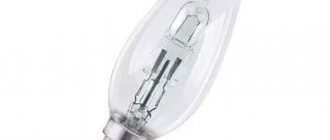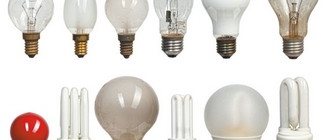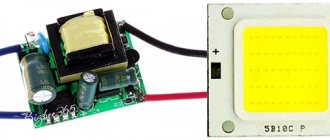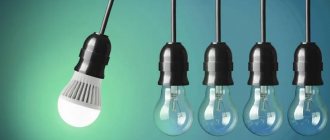The relationship between lumens and watts
Why is it not enough to use the usual watts? Everything is simple here. Power itself, measured in watts, is a more general characteristic. Let's take a 100W incandescent lamp as an example. Of these, 70 W will be spent on heating the space, that is, a device with this amount of power operates in a range invisible to humans. But 30 W is the light that we see.
Next, let's take energy-saving lamps that have been improved in this regard. There, the ratio of work in the visible and invisible ranges is different - 95 to 5. If the device has a power of 32 watts, then in the visible range it will operate at 30 watts.
That is, a 100 W incandescent lamp gives us 30 W light. And a 100 W energy saving lamp is almost three times more. The same goes for LED products. Here is a comparison table that will show how powerful a lamp must be to produce a certain number of lumens.
| Luminous flux in lumens (lm) | Incandescent lamp power (W) | Fluorescent lamp power (W) | LED lamp power (W) |
| 400 | 20 | 5-7 | 2-3 |
| 700 | 60 | 15-16 | 8-10 |
| 900 | 75 | 18-20 | 10-12 |
| 1200 | 100 | 25-30 | 12-15 |
| 1800 | 150 | 40-50 | 18-20 |
From this table it can be seen that to obtain, for example, 700 lumens, we will need to purchase a 60-watt incandescent lamp, but an LED lamp with 8-10 watts is sufficient. And here it becomes clear why the same LED devices are much more economical, because when we consume electricity, we pay for watts.
Or a comparison in the other direction: a 20-watt incandescent lamp and a 20-watt LED lamp produce enormously different numbers of lumens: 400 Lm and 1800 Lm, respectively. At the same time, we take into account: the higher this indicator, the better the lighting and the closer the light is to natural. This means good color rendition, less strain on the eyes, etc.
Note that the table offers approximate, average indicators. They may differ depending on the design of the products, their manufacturing technology, etc. We recommend that you check the indicators for each individual lamp - if the lumens are not indicated on the packaging, just remember the ratio of the efficiency of incandescent lamps and LED devices.
Purpose
The strength of the luminous flux depends on the illumination ratio. If it is insufficient, then vision will deteriorate. If it’s the other way around, your eyes will get tired quickly. That is, if you purchase sufficient lamp power, you can provide sufficient illumination. In addition, knowledge of this value will allow you to set the economical consumption of electricity. From the aesthetic side, you can also choose a beautiful and practical light. Therefore, this is an important indicator that should be studied before purchasing an analogue of an incandescent lamp, a device with a medium-brightness LED, or a fluorescent watt lamp.
To create a favorable atmosphere in the room, you need to know this value.
What is illumination and how to calculate its indicators?
Illumination is the level of luminous flux per 1 square meter. There is a separate value for this - lux (lx). That is, if one lumen of light falls on one square meter, this is equal to one lux: 1 lux = 1lm/m2.
Next, in order to calculate the required number of lumens per room, you need to know the sanitary standards developed for different rooms.
| Room type | Illumination standard |
| bathrooms (including bathtubs) in the apartment, as well as corridors, utility rooms | 50 lm/m2 |
| kitchen and living rooms: bedroom, living room | 150 lm/m2 |
| children's bedroom or playroom for a child | 200 lm/m2 |
| study, home office | 300 lm/m2 |
But you also need to take into account the height of the ceilings in the room. They don’t do this up to 2.7 meters, but then they add another factor.
| Room height (m.) | Additional coefficient for calculation |
| 2,7-3 | 1,2 |
| 3,1-3,5 | 1,5 |
| 3,5-4,5 | 2 |
Now we have all the data to calculate the minimum luminous flux. The formula looks like this:
Luminous flux (lm) = room area (m2) x standard illumination (lm/m2) x ceiling height factor (if any).
How to determine luminous flux and power
Determination of the flux and power of the lamp can be done using a special table, which is given below. To make your own measurements, you can use a spherical photometer or photometric goniometer. The main problem of independently finding the necessary data will be determining the parameters of the beam, which moves simultaneously in several directions.
Thanks to a spherical photometer, you can measure the energy of a scattered beam having a unit reflectance, and then compare the result with a standard. Using a photometric goniometer, which contains a lux meter, you can measure the illuminance over the entire source sphere. The received data is integrated into lumens.
You can also take the measurement yourself using a lux meter. At the end of the procedure, the data on illumination and area of the room are recorded, and then this information is substituted into the formula for calculating the beam: P=OPl.
You may be interested in: Types of LED lighting lamps and their characteristics
Measuring device lux meter to help
Here is an example of calculations
Let's say you have a children's room measuring 10 square meters and three meters high. In this case, we take the norm for children’s rooms - 200 lm/m2 and the coefficient for ceilings from 2.7 to 3 meters - 1.2.
We multiply these indicators: 10m2 x 200 lm/m2 x 1.2 = 2400 lm.
It turns out that for this nursery you need a luminous flux of 2400 lm. Based on this indicator, you can select the number and type of lamps by referring to our first table. This is a very convenient formula because it allows you to quickly and easily obtain indicators for each room.
Main types of fluorescent lamps
All lamps of this type are divided into two main categories. The first type is represented by general-purpose lighting devices, the power of which is in the range of 15-80 W. The color and spectral characteristics of these lamps make it possible to imitate various shades of natural light as much as possible.
The second type refers to special-purpose light bulbs. Various parameters are used to classify them. According to power, they are divided into low power lamps - up to 15 W and high power lamps - more than 80 W. These lamps have different types of discharge, so they are arc, as well as with glow discharge and glow. According to the light emitted, special lamps can be natural light, colored, with ultraviolet radiation and with separate emission spectra. The distribution of light occurs in different ways, that is, in the form of directional and non-directional light emission. The first option is represented by reflector, panel, slot and other light sources.
Are there any errors in the calculations?
Since we have already made allowances for the features of each individual lamp, it is fair to clarify that there will be errors in the calculations. The most accurate indicators of the required illumination can be obtained using a special device - a lux meter.
But the tables we provide allow us to achieve a minimum level of error - it will definitely not affect either comfort or health. If it is not possible to use professional calculations, you can calculate everything yourself and choose the optimal solution.
72682
Date of publication: 05/03/2018
Marking of fluorescent lamps
All fluorescent light bulbs are marked with letters. The letter L corresponds to the main name. Other letters are written according to the color of the radiation:
- D – daytime color;
- ХБ – cold white;
- TB – warm white;
- B – regular white;
- E – naturally white.
- Other letters, for example, K, ZH, Z, G, S, correspond to certain colors - red, yellow, green, blue and blue.
- The UV symbols indicate ultraviolet light.
- Lamps with improved color rendering quality are designated by the letter C, placed after the first color letters.
- The CC symbol indicates particularly high quality.
Differences in design and operating principle
For the first time, a patent was received for a light source with a tungsten filament by Russian scientist A.N. Lodygin in the 90s of the 19th century. Such lighting lamps operate on the principle of incandescent filament of a special tungsten alloy to very high temperatures, which inevitably leads to glow. Structurally, such a device consists of a glass flask with a chemically inert gas inside (for example, a mixture of nitrogen with argon), a tungsten filament (incandescent filament), molybdenum filament holders with other elements for holding the filament, and electrical conductors with a base at the bottom of the lamp.
Such lamps are widely used in all spheres of human activity, but are gradually being replaced by modern and efficient LED lighting devices.
LED lamps were discovered at the beginning of the 20th century, but were first used in practical use only in 1962, when an American scientist from the University of Illinois, Nick Holonyak, obtained crystals with a red glow. The principle of LED luminescence is based on the electric-hole junction characteristic of semiconductor elements. When electric current passes in the forward direction through the LED, photons are emitted and a glow appears.
With the development and improvement of technological processes, the production of LEDs has ceased to be expensive and LED lamps have become widespread, rapidly displacing incandescent lamps from the market. All this happens because such devices have a high efficiency and, at low power, have a high luminous flux.
HDMI cable
HDMI cable: no sound on TV
HDMI is a modern standard cable designed for high-speed transmission of high-quality digital audio and video signals:
- The cable design features protect the transmitted information from possible copying, but this is more of an informational addition that is not useful to the average user.
- Before HDMI, a DVI cable was used to transmit a digital signal, which is still used today when connecting computer equipment, but unlike its predecessor, HDMI has more compact dimensions and is capable of transmitting sound, which contributed to the rapid introduction of this standard into consumer electronics.
- These cables are used to connect not only computers to the TV, but also: projectors, photo and video cameras, DVD and Blu-Ray players, satellite receivers, modern game consoles and other digital equipment.
Advice! If the paired devices in your multimedia system have HDMI outputs, but for some reason you never used them, then be sure to purchase this cable. You will immediately notice the difference in image quality with the naked eye.
DVI and HDMI 1.4 cable: no sound
Cable types and properties
What is remarkable about this standard is the full compatibility of cables of different generations. But, nevertheless, each model has its own characteristics, which distinguish it from its predecessors.
Cable Standards
All cables produced today differ in manufacturing standards. That is, in fact, we have several types of HDMI:
- Standard (Standard) - a model that supports video transmission with a resolution of 720p or 1080i. The maximum throughput is 4.9 Gbps, and the color depth is 24 bits. In fact, it is a budget solution, since the price for a 1.5 m cable does not exceed 300 rubles. Suitable for most undemanding users, or when connecting devices that are not capable of producing a higher quality picture (receiver, DVD, etc.)
- High Speed - has a throughput of 10.2 Gbps, and supports 48-bit color. Goes well with 3D and Deep Color technologies. It has a reverse audio channel for data transmission without using an S\PDIF connection. It is used when connecting to high-speed devices such as Blu-Ray, as it is capable of producing images with a resolution of up to 4K (4096x2160 pixels).
- Standard with Ethernet - this cable is similar to the first one on our list, but has a separate channel for transmitting data via Ethernet (Internet connection). Like any Internet cable, it provides bidirectional data transfer at speeds of up to 100 Mbit/sec. Another difference from the standard version is support for reverse audio channel.
- High Speed with Ethernet - we think everyone has already guessed about the capabilities of this model. It’s only worth noting that it has maximum capabilities for cables version 1.4 (we’ll talk about versions below).
- Standard Automotive is a very specific cable that is mainly used by professionals when connecting devices that transmit HDMI signals to a car multimedia system.
Attention! It makes sense to use Ethernet-enabled cables only when both connected devices support this technology. In this case, you can not only organize a high-speed Internet connection, but also transfer content to other connected devices.
HDMI cable versions
HDMI version 2.0
The listed types are not the only criterion by which HDMI cables differ. The development of a unified digital standard began with such eminent companies as Sony, Phillips, Thompson, Hitachi and others. The result of the joint efforts of these companies was the HDMI cable version 1.0, which was released back in 2002.
- This development became a breakthrough in the world of electronics, and very soon it firmly occupied its niche, gradually displacing all other connection formats.
- The advantages of the new product include not only a new level and image quality, but also ease of connection - one cable replaced entire bundles of wires, which is especially noticeable when connecting speaker systems with multi-channel sound.
- Over time, the HDMI format received a new impetus for development. Developers began to produce more advanced versions of wires, giving them new functions and capabilities. But, what’s especially nice is not forgetting to keep new versions compatible with old devices.
Today, the most advanced version is cable version 2.0, the capabilities of which are disproportionately higher than those of its “first ancestor”. This standard incorporates all the advantages of previous versions.
Now HDMI wires can not only transmit images and sound of the highest quality, but also, for example, control consumer electronics, transmit a 3D signal, connect TV to the Internet, synchronize video and audio streams, and much more.
Advice! If you are interested in the complete specifications for all versions of HDMI cables, then look for tables and diagrams on the Internet. If possible, we will try to post this information on our website as soon as possible.
Types of connectors and cable lengths
Basic types of connectors for an HDMI cable
Despite the general trend towards standardization, the use of any connection format cannot remain unchanged. This fact is due to the fact that most modern electronic devices have become noticeably smaller, moreover, powerful smartphones, tablets and compact computers have become firmly established in our lives, which led to the development of new standards that could allow them to be connected to TVs.
Connecting modern electronic devices
As a result, new types of HDMI cables were developed and released, with specific plugs, for certain types of tasks and devices.
According to the new specification, their number was five, which were coded in capital letters of the Latin alphabet:
- Type A (Standard) - this designation was given to the first connector that we discussed earlier;
- Type B - less popular than the previous type, although it has an expanded channel for transmitting video with a resolution of 1080p;
- Type C and D are mini and micro connectors, respectively. In essence, they are a smaller copy of type “A”, and are designed to connect compact digital equipment (tablets, laptops, etc.);
- Type E - the connector design has a special lock that secures the cable in the socket. Most often, it is used in automotive systems subject to constant shaking and vibration.
One more important information can be extracted from the specifications for HDMI cables - the length of all cables is strictly regulated. The minimum wire size is 0.75 meters and the maximum is 10 meters.
If you are offered a larger version 1.4 cable, then remember that this option is not regulated by standards, and most likely it will not be able to produce a picture of the required quality. This means that those who like to buy wires with a reserve will not be able to roam around here, because when connected, such HDMI will lose and distort the signal.
But don’t think that cable size is the only thing that affects picture quality. This factor also depends on the material from which the wire is made. Also, the thickness of the cores also affects - in higher-speed models, they are larger in diameter. But if you still need to run the cable over a long distance, then consider using a signal amplifier that will prevent you from losing it.
Summarizing this chapter, we emphasize that the use of expensive metals in production greatly affects the final cost of the product. For example, there are models whose price exceeds 7 - 8 thousand rubles. Therefore, when choosing a cable, you must first focus on your needs. We'll tell you how to do this further.
Choosing an HDMI cable
Choosing the right cable
We cannot say with complete confidence that this material is a complete guide to choosing a cable. Rather, these are a few tips and notes that may be useful to you when purchasing, and not become a victim of some unscrupulous seller.
- Let's start with the fact that, despite the specification requirements, HDMI cables can be significantly longer than the values mentioned above. But it is worth knowing some features of its design.
- As already mentioned, a cable that is too long loses the signal and distorts it at the output. To prevent this from happening, use HDMI equalizers (amplifiers), or use a specially designed unidirectional cable that has a built-in repeater that replaces a separate amplifying device. In addition, the cross-sectional diameter of the conductors of such cables must be larger than that of standard ones.
- There is some unspoken standard for the ratio of lengths and diameters of the conductor: 5 m - 28 AWG (0.321 mm); 10 m - 26 AWG (0.405 mm); 15 m - 24 AWG (0.511 mm); 20 m - 22 AWG (0.644 mm), etc.
- AWG is an American wire sizing standard in which larger numbers mean smaller wire diameter. This is the marking that occurs most often, but for convenience we have added values in the usual mm.
Advice! If the cable does not have the indicated marking, then it is quite possible that this is a low-quality product that you should refrain from purchasing.
HDMI cable with gold plating
- There is an opinion that HDMI cables with gold plating on the contacts are capable of transmitting a signal with less loss of quality. The cost of such models is, to put it mildly, quite high. In fact, there will be no difference in quality, and there is no need to overpay for gold.
- Sputtering does not act as a conductor at all, but as a protection against oxidation. Yes, indeed, the oxide that forms over time can greatly affect the quality of the picture, but you can deal with it differently. For the same purposes, plating of nickel and chromium is used, which have higher strength than soft gold, and at the same time protect contacts just as well.
- In general, you should use such protection only when using the product in a humid climate or damp rooms. And don’t forget that it makes no sense to use a protected cable if the corresponding jack on the TV does not have the same protection.
Shielded cable
What else can you pay attention to when choosing a cable? A high-quality product will always have a screen that will protect the signal from internal and external interference. The optimal structure is considered to be a “twisted pair” type (each signal wire is intertwined with “ground”), protected from external interference by a foil braid.
It would not be amiss to have a pair of ferrite filters, which are made in the form of massive rings at the ends of the cable. This protection will save you from high-frequency external interference.
Lamp parameters and mains voltage
There are tables that show in comparative form the characteristics of the most common fluorescent lamps. For example, if the voltage in the electrical network drops below permissible limits, the restart process is significantly deteriorated. And, conversely, if the voltage increases significantly, this can lead to overheating of the cathodes and overheating of the ballasts. In all cases where normal operating conditions are violated, the service life of fluorescent lamps is significantly reduced.
| Type | Power P (W) | Lamp voltage U (V) | Lamp current I (A) | Luminous flux R (lm) | Luminous efficacy S (lm/W) |
| LDC | 15 | 58 | 0,3 | 450 | 30 |
| LD LHB | 15 | 58 | 0,3 | 525 | 35 |
| LB | 15 | 58 | 0,3 | 630 | 42 |
| LTB | 15 | 58 | 0,3 | 600 | 40 |
| LDC | 20 | 60 | 0,35 | 620 | 31 |
| LD | 20 | 60 | 0,35 | 760 | 39 |
The characteristics of all other types of fluorescent lamps are displayed in the same way. It should be remembered that lamps with the same markings may have significantly different parameters due to differences in their overall dimensions.
Life time
Everyone is familiar with the situation when an incandescent lamp “burns out”. Any voltage surge when the device is running or sudden switching on when the tungsten filament is worn leads to damage to the incandescent lamp. It is precisely because of the high sensitivity of the filament that ordinary lamps have a short service life, and low-quality incandescent lamps only last a few days.
Energy-saving LED lamps have a fundamentally different design and predictable service life. Such devices last ten times longer than incandescent lamps and can operate up to 50,000 hours (for comparison, the average service life of incandescent lamps does not exceed 1000 hours).
Types of lamp bases
In domestic conditions, lamps with three types of bases are used: small, medium and large, or, in technical terms, E14, E27 and E40. The numbers in the name indicate the diameter of the base in millimeters. The most common base size is E27. The E14 base is often called “mignon” (translated from French as “small”). The E40 socket is used for street lighting lamps with a power of 300, 500 and 1000 W.
In addition to bases that are screwed into the socket using a thread, there are types of pin-type lamp bases. They are called G-sockets. Their main types are G5, G9, 2G10, 2G11, G23 and R7s-7. G-bases are used in compact fluorescent and halogen lamps to save space. Using two or four pins, the lamp is attached to the lamp socket.
Classification
Incandescent lamps
In the recent past, the most common type. Lighting devices of this type can be used on both stationary and portable devices (for example, hand-held flashlights).
Light is emitted by a heated tungsten filament placed in a flask (balloon) from which air has been evacuated (hence the term “vacuum”).
Based on the composition of the gas in the cylinder, incandescent lamps are divided into vacuum lamps, krypton lamps, and halogen lamps.
Vacuum
The surface of the bulb can be either transparent or matte, which allows you to get softer light without using a protective cap. Also, the top of the cylinder can be coated with mirror paint to direct the light flux downwards (for ceiling lighting).
Lamps for portable sources operate on voltages of 12, 24, 36 V.
For stationary ones - 220 V, 50 Hz (city electrical network).
The main disadvantage of such light sources is low efficiency: only 2-3% goes to lighting. The rest of the energy is dissipated as heat (hence the low luminous efficiency).
The type of fastening used is Edison base (E-base); differs in its diameter (in mm), indicated in the marking:
- E10 – used for flashlights;
- E14, also called "minyon" (small);
- E27 – standard;
- E40 is used for outdoor lighting;
Pros:
- widespread use of equipment;
- low price;
- ease of installation;
Minuses:
- low efficiency;
- short operating time (500–1000 hours);
- fire hazard (cannot be used in plastic and wooden structures);
Characteristics:
| Base | E |
| Power | 5 – 500 W |
| Luminous output | 7–17 lm/W |
| Color rendering Ra | more than 90 |
| Light temperature | 2700 K |
| Price | from 10 rub. |
| Life time | 500–1000 hours |
Krypton lamps
An incandescent lamp with krypton (an inert gas) added to its cylinder. They have smaller dimensions and longer operating time compared to vacuum ones (1000–2000 hours), and are not sensitive to voltage changes.
Characteristics:
| Base | E |
| Power | 5 – 500 W |
| Luminous output | 8–19 lm/W |
| Color rendering Ra | more than 90 |
| Light temperature | 2700 K |
| Price | from 40 rub. |
| Life time | 1000–2000 hours |
Halogen lamps
As the name suggests, the flask contains pairs of halogens (elements of group 17 of the periodic table - bromine or iodine). The addition of these gases allows you to significantly increase operating time and increase light output compared to vacuum analogues.
An E- or G-base is used (see fluorescent lamps).
Pros:
- Service life up to 2000-4000 hours.
- Small size , possible use in plasterboard structures (for example, suspended ceilings).
Minuses:
- Sensitivity to contamination (installation must be done with gloves; if grease gets on the surface of the flask, the device quickly fails).
- Sensitivity to voltage changes.
Currently, a new type of halogen sources with an infrared coating has been developed, which transmits visible light and reflects thermal radiation; they have reduced energy consumption and increased operating time compared to their uncoated counterparts.
Characteristics:
| Base | E, G |
| Power | 20 – 1500 W |
| Luminous output | 14–30 lm/W |
| Color rendering Ra | more than 90 |
| Light temperature | 3700 K |
| Price | from 20 |
| Life time | 2000–4000 h. |










